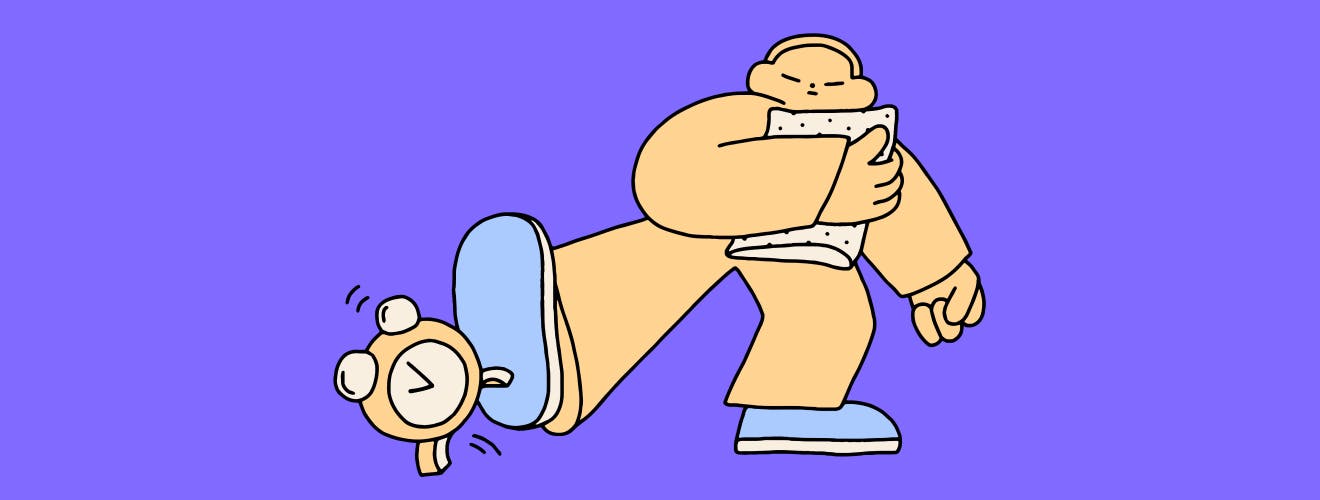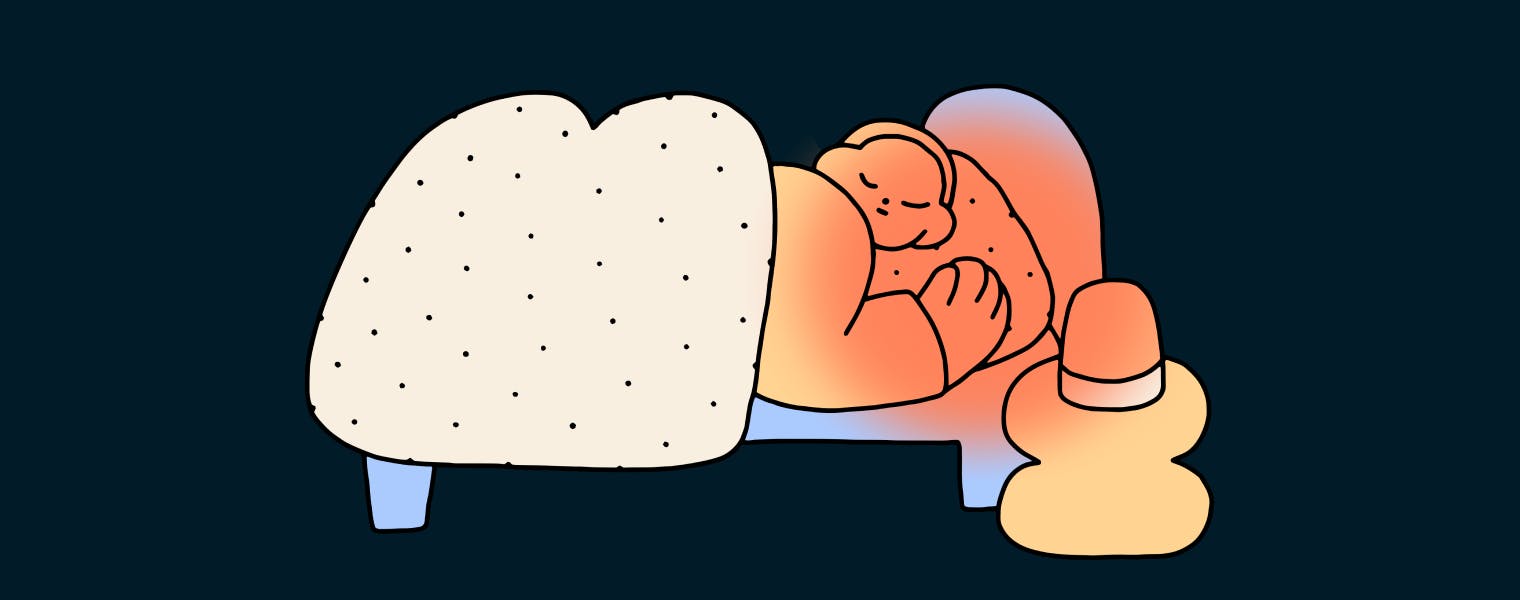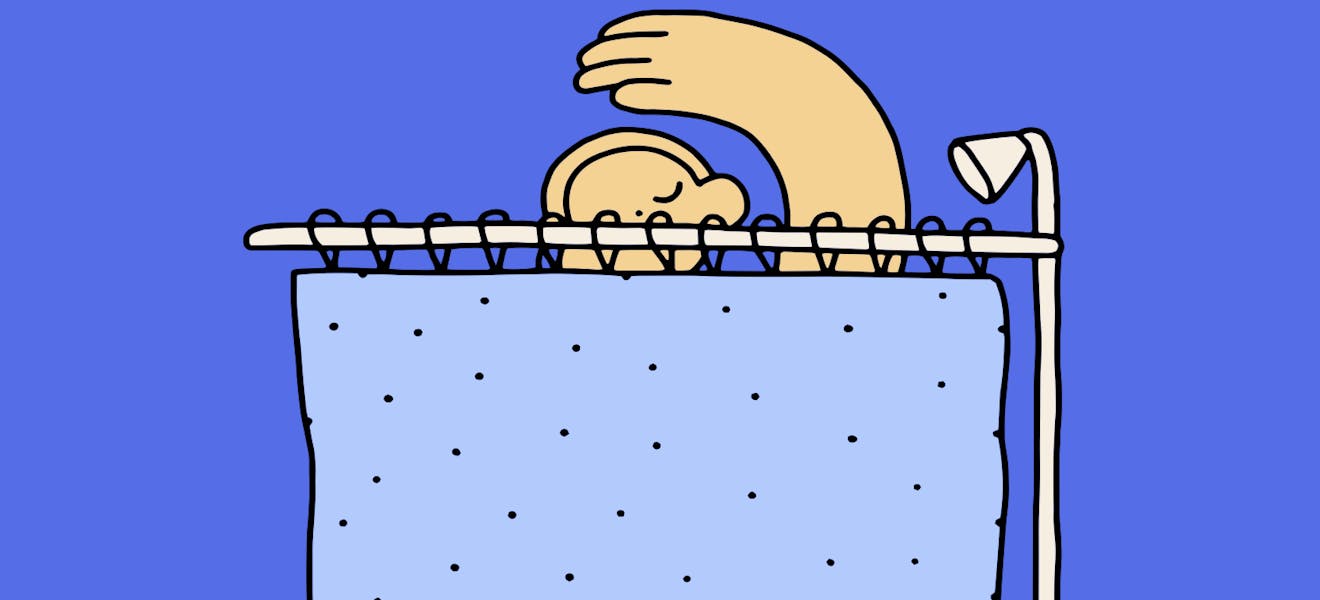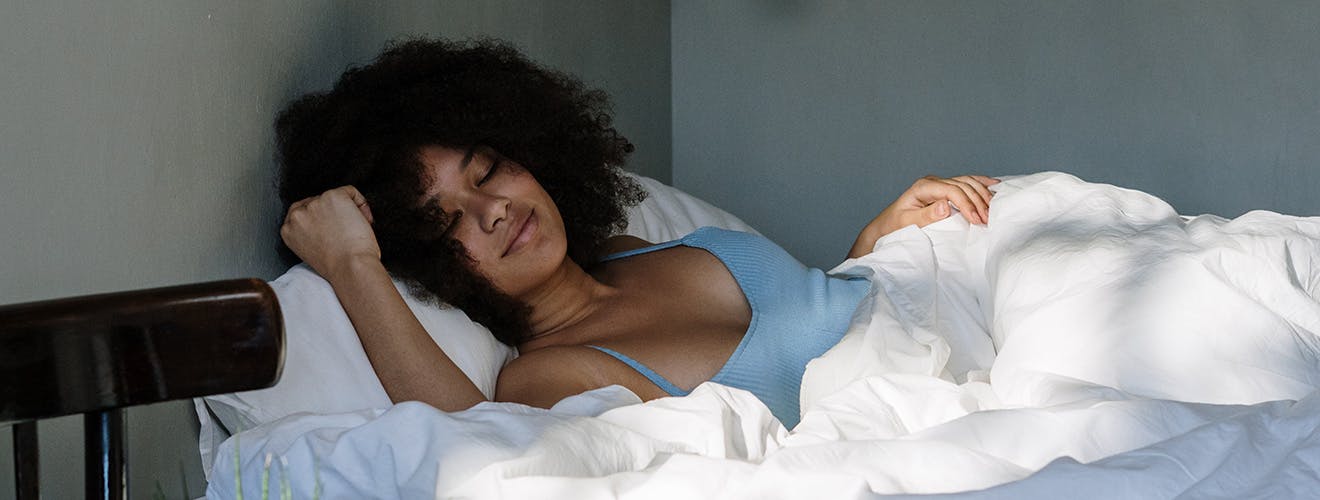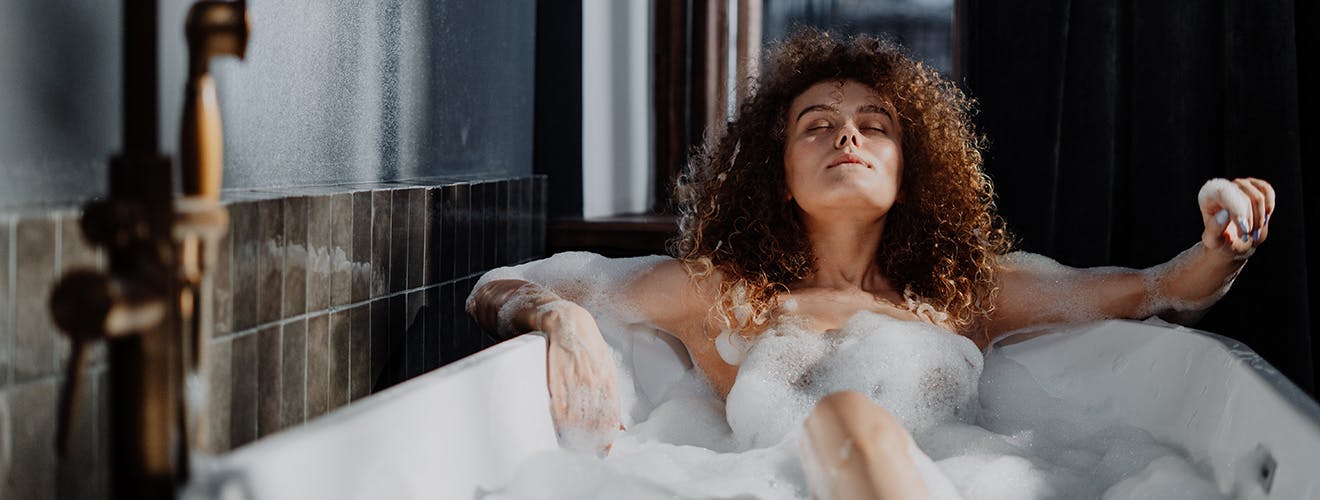Your Guide to Microsleep
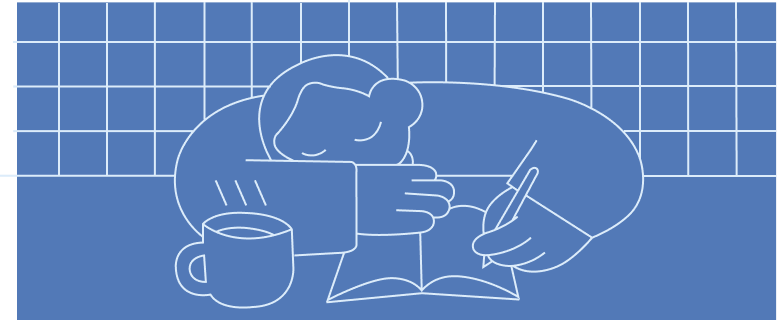
Have you ever felt that sudden jerk and woken up in the middle of a lecture? Maybe it happened when you went to school sleep-deprived or after a series of night shifts. Maybe it even happened to a driver you were traveling with. This common occurrence is a medically reviewed phenomenon and even has a name — Microsleep. While microsleep events happen thousands of times every minute across the world, microsleep is nothing to be taken lightly. Let’s look deeper into the symptoms, causes, dangers, and treatments of microsleeps.
What is Microsleep?
As the name suggests, microsleep refers to a short duration of sleep. This usually lasts for less than 30 seconds and occurs when a person gets fewer than 7 to 9 hours of sleep.
Patients that are micro-sleeping aren’t aware they’re doing it. However, the phenomenon is characterized by the multiple episodes of microsleeps that occur close together. During this, the person tries to stay awake but keeps falling asleep. The person might be tired from a long day, have sleep disorders, a health issue, or simply be drowsy from a lack of sleep.
Another characteristic of micro-sleeping is the rapid switching of the person’s brain from awake to asleep mode. Here’s what the National Institute for Occupational Safety and Health (NIOSH) says: “A sleep-deprived person cannot control the onset of microsleeps and often is unaware that they are occurring.”
Microsleep activity is also detectable on ambulatory EEG. NIOSH also says there is a strong correlation between microsleep and car accidents. While the estimates from National Highway Traffic Safety Administration show a link between drowsy drivers and 6,000 fatal car accidents every year.
But what exactly happens in the brain during microsleeps? When you go for a long period of sleep deprivation, your body collects deposits of adenosine, nitric oxide, and more substances that are known to put sleep pressure on your brain and body. Ultimately the pressure gets so difficult that you have a microsleep episode.
The events have been commonly associated with those such as ‘mind blanking’ and ‘mind-wandering.’ In all these events, the brain falls asleep or loses consciousness for a few seconds and regains quickly. However, during this brief period, certain parts of the brain are still active. This is one explanation of why sensory stimuli might be perceived differently during microsleep.
Additional research shows a connection between pupil dilation and microsleep. This data should be taken into account with the research showing an increase in neural activity with the closure of the eyes triggered due to drowsiness.
Microsleep episodes can also cause the brain waves to slow down. This can be measured using an EEG also known as an electroencephalogram. It has also been observed that brain activity during microsleep is very different from that during regular sleep.
For example, the brain emits slower theta waves during microsleep, faster alpha waves during wakefulness, and delta waves during deep sleep. This can be studied and observed using functional magnetic resonance imaging (fMRI).
Certain parts of the brain that are inactive during regular sleep are active during microsleep. The brain also alters its response mechanisms and reaction time when micro-sleeping. These points aren’t conclusive. However, they do suggest there is a big difference between regular sleep and microsleep.
Symptoms of Microsleep
Symptoms of microsleep may get worse based on the period microsleep has been occurring for and include:
- Trouble focusing/ concentrating
- Blank staring
- Heavy eyelids
- Drowsiness/ Excessive daytime sleepiness
- Pupil dilation
- Slow movement of eyes
- Reduced response to external stimuli like sound or visuals
- Excessive blinking or yawning
- Trouble processing information
- Reduced physical strength
- Decreased immunity/ falls sick often
- Reduced awareness of situations you’re in
- Memory problems
- Awakened by body jerks when your head falls forward
- Mood swings
- Risk of mental illness
- Hallucinations
- Risk of asthma and stroke
- Risk of depression
- Obstructive sleep apnea
- Narcolepsy
If you find yourself with any of these symptoms then make sure to check in with a medical professional and get the medical advice, diagnosis, or treatment you need.
Dangers of Microsleep
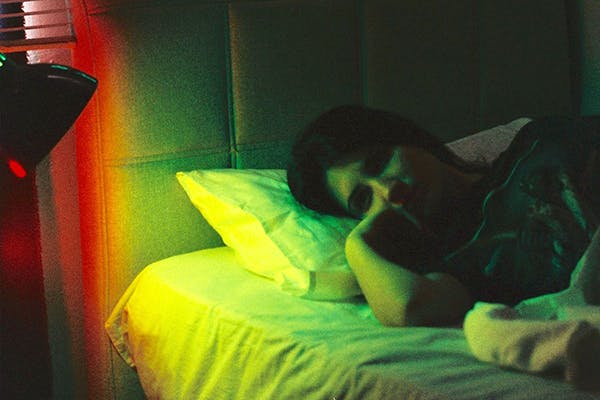
Microsleep can be very dangerous, as the brain completely shuts off during those few seconds. Unlike regular nap time or nighttime sleep, microsleep can occur when the person is eating, driving, or sitting in a classroom.
In this sense, microsleep is only dangerous depending on the situation in which it occurs. A child falling asleep in a classroom can be funny or punishable but less likely to result in serious consequences.
However, some other situations can. The biggest risk of microsleep is when you're out on the roads driving drowsy while experiencing microsleep. Drowsy driving can cause fatal crashes on the road. Driving sleep-deprived can be a threat to public safety workers, pedestrians, a fellow driver, or a passenger
Some professions in which micro-sleeping can be dangerous are:
- Truck driving
- Pilot
- Locomotive driver
- Medical professions
- Air traffic controller
- Process worker in a plant or factory
- Operator driving heavy machinery
- Professionals doing shift work
Microsleep and Sleep Deprivation
The main causes of microsleep are not that difficult to guess - it is primarily caused by a lack of sleep. Sometimes, even a single night without sleep (of 4 hours or less) could result in sleep deprivation.
Sleep deprivation is more common than you may have thought. Even those who think they are sleeping well might not be getting the required amount of sleep required to combat sleep deprivation.
That isn’t to say sleep deprivation is the only cause of microsleep. There are several factors from physical diseases to mental disorders that could cause microsleep tendencies in a person.
Some of the more common reasons include tension, stress, and schedule changes that don't need a doctor’s appointment. A rare disease or psychological condition, however, might require medical intervention.
Other Things That Contribute to Microsleep Episodes
- Shift work or long work hours
- 24/7 digital and internet access
- Aging
- Sleep disorders
- Diabetes and blood sugar problems
- Sleep apnea
- High blood pressure
- Restless leg syndrome
- Alzheimer’s
- Schizophrenia
- Chronic pain syndrome
- Obesity
- Depression
- Anxiety
- Stress
- Cancer
- Stroke
- Medication for Parkinson’s disease
One study from the National Library of Medicine found driving-related car accidents increase when the night shift workers did not get enough sleep the night before. In the same study, those doing the shift work had zero driving accidents after a good night’s sleep.
It is also common to see microsleep occurring in people who have a regular sleeping schedule. Boredom or monotonous activity in healthy adults, for example, could also make them sleepy during the daytime. Benzodiazepines, epilepsy drugs, heart medications, and antihistamine medicine can induce excessive daytime sleepiness.
Effects of Sleep Deprivation
We know all about the dangers of microsleep and the causes of sleep deprivation. Let’s also take a look at the effects of sleep deprivation:
- Drowsy driving
- Excessive daytime sleepiness
- Forgetfulness
- Poor performance in everyday activities
- Tired and lethargic movements
- Mood swings
- High blood pressure
- Obesity
- Heart attacks
- Drops in workplace performance
- Increased risk of disease
Sleep deprivation could also cause you to get into fatal crashes when on the road.
When Do Microsleep Episodes Occur?
Microsleep episodes can occur at any time of the day. However, most episodes occur in the afternoon. The condition is also referred to as a post-lunch dip or afternoon slump. Another window of time is early morning or late night.
Monotony can also trigger sleepiness. Monotony can be experienced while driving down open roads, riding an airplane or train, sitting in a waiting room, doing repetitive or stationary work - most of us have experienced microsleep episodes in these scenarios.
In contrast, microsleep episodes for night shift workers occur early in the morning when they’re getting off of work.
How Much Sleep is Required by Adults and Children?
As per the medically reviewed data from the National Sleep Foundation, newborns need 14 to 17 hours of sleep. Infants need 12 to 16 hours and toddlers 11 to 14 hours. Preschoolers need a healthy 10 to 13 hours of sleep.
At the age of 6 and up to 18 years old, 9 to 12 hours should be enough sleep. Adults need at least 7 hours of quality sleep every night. Less than 7 hours means more microsleeps and poor health.
However, these numbers are rarely followed, with current data showing that at least for adults in the United States, healthy sleep hours are hard to come by.
Diagnosing Microsleep
A multiple sleep latency test (MSLT) can help doctors diagnose microsleeps. It is a test that can measure a person's tendency to fall asleep but under controlled conditions. However, the test is more commonly used for diagnosing narcolepsy and idiopathic hypersomnia.
That is where medically reviewed psychological, speech, and behavioral tests come in. There are also other ways of diagnosing microsleep that we’ve discussed through the article. These include:
- Electroencephalography (EEG)
- Functional magnetic resonance imaging(fMRI)
- Electrooculogram (EOG)
- Polysomnography (PSG)
Diagnosing Sleep Deprivation
There is little uniformity in the medical field over the testing of sleep-related problems. That said, sleep deprivation symptoms can be seen long before episodes of microsleep start to show. However, the initial symptoms remain the same. Such as:
- Drowsiness
- Excessive daytime sleepiness
- Excessive blinking
- Yawning
One telltale sign is falling asleep within minutes of hitting the bed. Typically, five minutes or less. In serious conditions, the doctor will conduct a sleep study called polysomnography. Such conditions/ symptoms include:
- Obstructive sleep apnea
- Narcolepsy
- Unexplained chronic insomnia
- REM sleep behavior disorder
- Unusual behaviors during sleep
- Periodic limb movement disorder
- Sleep-related breathing disorder
Treatment for Microsleep and Sleep Deprivation
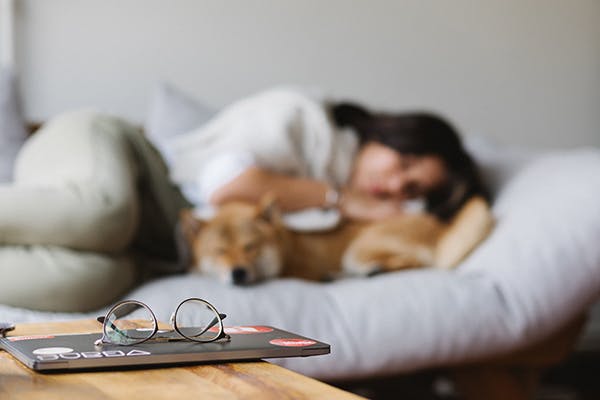
Treatments for sleep deprivation aren’t always the same for every person. Treatment may differ based on the severity of the disorder, progression of illness, and its cause.
Often the condition is not even considered a disorder so getting treatment for a lot of patients might be delayed. However, here are some treatments that can help you manage the episode better:
- First, identifying signs of microsleep and taking necessary safety precautions
- Driver monitoring systems
- Self-care methods
- Medication
- Sleeping pills
- Light therapy
- Breathing machines (CPAP or continuous positive airway pressure)
Prevention of Microsleep
While curing microsleep can be a complicated issue, preventing it is much simpler and can be done by following some of these tips:
Sleep 8 hours every day
Your body has a circadian rhythm that will take over and let you know when it is sleepy. It might take a few days but you will slowly be able to go to bed on time and wake up feeling refreshed.
Avoid listening to loud music
No, it is not going to induce wakefulness in you - when tired, using loud music to keep yourself up may actually increase the severity of your microsleep episodes.
Break monotony
Monotony can make you bored which can make you sleepier. Try to get up and move a little to wake up your body. Do some stretches or step outside and take a walk in nature.
Light is also known to affect your circadian rhythm, commonly known as the body clock. Just how a dark room can make sleeping easier, a brightly lit room will make you feel awake.
Take power naps
Giving in to microsleeps is perhaps the best advice you’ll hear and it is also very effective. Taking power naps of 15-20 minutes can boost your alertness and make you more energetic as well.
So, the next time you feel yourself jolting awake from a microsleep episode, give in and find a comfortable place to rest your head. It would also be great to make yourself warm and put on an eye mask.
If you’re afraid of oversleeping, try putting on an alarm or ask someone to wake you up. Research shows that different nap durations during the day can affect the brain in different ways. A 20-minute nap boosts memory, while a 30-minute nap can improve decision-making skills.
Note that this doesn’t mean you can skip nighttime sleep and take daytime naps instead. There is no medical evidence to prove any amount of naps can compensate for regular sleep across several hours.
In contrast to this, the National Library of Medicine Research suggests that a microsleep episode can impair the decision-making ability of patients.
Talk to someone
If you can talk to someone then try it! Have a conversation that will wake up your brain and get rid of any excessive daytime sleepiness. Research shows that talking can induce feelings of wakefulness in the speaker - so strike up a chat if you need to stay awake.
Drink some caffeine
Caffeine mimics adenosine’s effects on the body and helps it stay awake. This is one way of keeping your body alert - although it can come at a cost.
Long-term consumption can increase your tolerance to caffeine, creates wakefulness, and also makes your work performance poor. This means you will have to keep consuming more quantities of caffeine to stay awake. If you rarely consume it then there should be no reason to worry.
Avoid drinking coffee in the evening as it takes a few hours for its effects to wear off and it may keep you awake at night.
Prevention of Sleep Deprivation
Things to avoid
- Avoid drinking or consuming caffeine, alcohol, nicotine, etc.
- Quit smoking
- Don’t eat a large meal before bed
- Don’t eat anything too stimulating for dinner. It’ll raise your heart rate or sugar levels
- Avoid driving with a sleep-related illness
Things to do
- Exercise 5-6 hours before going to bed for 20-30 minutes every day
- Have an early dinner
- Sleep and wake up at a fixed time every day
- Wake up with the sun every morning
- Turn all devices off an hour before bedtime
- Adjust the temperature in your bedroom
- Make sure no lights from the street enter the bedroom
- Use an eye mask
Manage Sleep Deprivation
What you do before you go to bed can make a huge impact on your quality of sleep. Certain activities are known to help make the person feel relaxed and make it easier for them to fall asleep as well. Activities such as:
- Yoga
- Light stretching
- Taking a warm bath
- Light reading
- Meditation
You can also try to get plenty of movement during the day to keep yourself fresh and active. Medical data shows exercise can help you combat daytime sleepiness and sleep better at night.
Conclusion
Overall, the thing to remember is sleep deprivation and microsleeps aren’t all that different. One is the cause while another is the symptom, though it can be hard for a person to diagnose it by themselves.
If you see some of these symptoms or think you’re having episodes of microsleep, consult a medical professional. Only a medical professional can give you reliable advice, diagnosis, or treatment. They can also confirm whether a medically reviewed medicine is actually useful or dangerous to your health.
Now, we know there are plenty of over-the-counter medications for sleep disorders. But why put your health at risk when you only need to get a good rest at night? Sandland Sleep brings you a natural sleep medicine.
Our fast-acting and long-lasting sleep aid herbal supplements are made from neutral hemp-derived ingredients. So, you can cash in on some sleep with 100% safety and without relying on harmful supplements or drugs.
Microsleeps last anywhere from 1 to 30 seconds.
Heavy eyelids, drowsiness, difficulty focusing, and excessive daytime sleepiness are some of the first signs of microsleeps. If you are experiencing microsleep symptoms like any of these then you need to stop and take a nap or take a break.
While there are dangers to microsleep, its function might be beneficial for your health. It may help to restore responsiveness, as per the medically reviewed data from the National Library of Medicine.
The microsleep state is categorized by the slower theta waves emitted by the brain. This wave activity is generally seen on EEG devices. Theta waves are commonly seen during the stage 2 sleep cycle. To be able to dream the brain should enter the stage 3 or stage 4 sleep cycle.
Therefore, dreaming is usually not possible during microsleep. However, due to altered sensory perception for a few seconds the person may feel that way. Check out more data on sleep cycles and microsleep.
There’s not enough research to conclude whether microsleeps are good for the body. It helps restore the body’s performance, however, only if the person is resting. Microsleep itself might not be good or bad. However, if you experience microsleeps while working or driving at night or during the day, then it can be deadly.
It is not possible to voluntarily microsleep. However, by going without a single night of sleep you might experience microsleep episodes.
Sleep deprivation is one of the most common causes of microsleep. However, if a healthy adult with a good sleeping routine experiences microsleep episodes, then there may be an underlying reason that needs medical attention. Another cause for microsleep in a healthy adult is the lack of REM and non-REM sleep.
